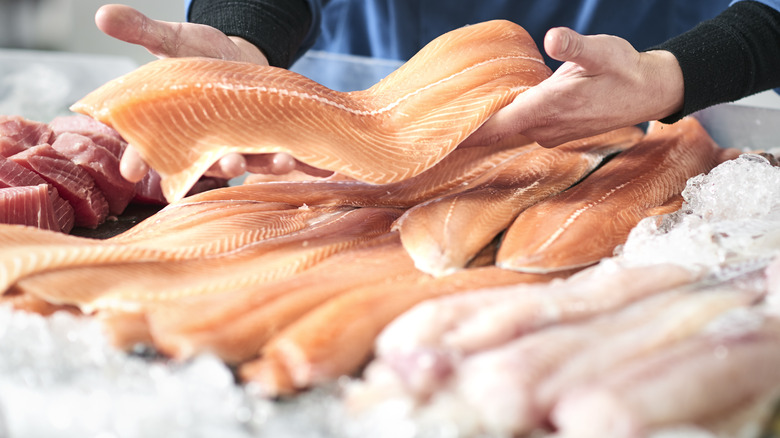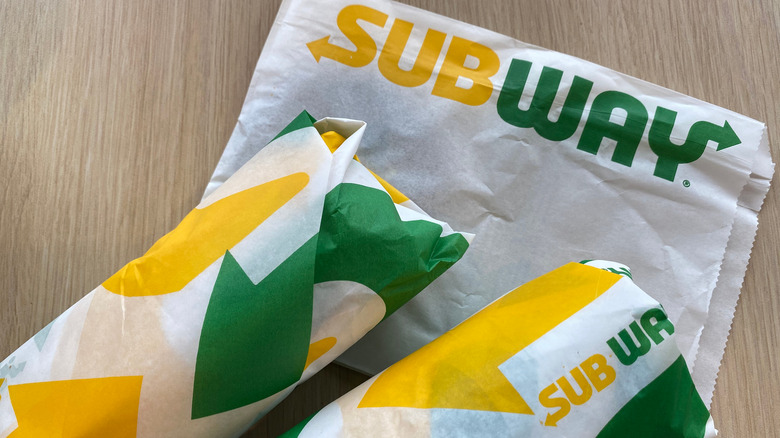What This Recent Lab Test Revealed About Subway's Tuna Sandwich
If you're a fan of Subway's tuna sandwiches, we may have some bad news for you. According to The New York Times, after public declarations from Subway saying that its tuna and seafood sourcing departments distribute only skipjack and yellowfin tuna to use in sandwich fillings, lab tests conducted on behalf of the outlet on Subway's tuna-filled masterpieces show that not only were the samples clear of any skipjack or yellowfin tuna, "No amplifiable tuna DNA was present in the sample and so we obtained no amplification products from the DNA. Therefore, we cannot identify the species."
The results came from tests conducted on Subway sandwiches sourced from three different shops around the Los Angeles area, and shipped to a facility, whose area of expertise is fish testing. The laboratory used a PCR test, which could make millions of copies from a DNA sample, which in turn could show whether the sample came from five of 15 different types of saltwater fish that are allowed to be labelled as tuna. A spokesperson for the testing lab says only two conclusions can be drawn from these results — that the filling is heavily processed, making it difficult to identify, or that it simply isn't tuna.
Seafood fraud happens more often than you would think
Unfortunately, mislabeling fish, also known as seafood fraud, happens more often than you might think. Oceana, an ocean-based conservancy, says that anywhere from between 26 to 87% of fish like grouper, cod, and snapper are swapped with fish that are cheaper and more readily available, and that snapper and tuna are considered to be the most commonly mislabeled fish. According to Oceana, tuna is mislabeled 59% of the time. The group also pointed out that 84% of white tuna samples were actually escolar (which The Kitchn says is also known as "snake mackerel"). Unfortunately, this can trigger unpleasant digestive problems for some people that consume larger quantities of mislabeled tuna. While escolar is not considered toxic (which is why the FDA allows it to be sold in the United States), it should not be consumed in servings that weigh more than 6 ounces. In fact, in Canada, Denmark, and Sweden, escolar is sold with a warning label.
To its credit, Subway's sandwich artists say there is no way of knowing whether a pack of tuna is just that, because it arrives at the facility pressed and in a vacuum sealed container. When the containers are opened, they reveal flaky fish which are then mixed with mayo. Seafood experts say there is no reason for a sandwich chain like Subway to mislabel its ingredients. When asked to comment on the matter, President of Catalina Offshore Products, Dave Rudie, told The New York Times, "I don't think a sandwich place would intentionally mislabel. They're buying a can of tuna that says 'tuna'. If there's any fraud in this case, it happened at the cannery."
Lab tests on Subway's tuna sandwiches have returned mixed results
This would not be the first time lab tests on Subway's popular tuna sandwiches have shown the filling to be anything but tuna. Subway is being sued by complainants, who say that the restaurant is deliberately misleading its diners by marking the sandwich filling as tuna when it isn't. The lawsuit alleges that their lab tests revealed that what Subway called "tuna" was actually "a mixture of various concoctions that do not constitute tuna, yet have been blended together by defendants to imitate the appearance of tuna" (via The Washington Post). But it doesn't always happen this way, other lab tests conducted by Inside Edition showed the tuna sandwiches to be what they said they were (via The New York Times).
In the event that there is some kind of fraud taking place, Subway can likely be seen as a victim, rather than the perpetrator. "In the defense of Subway, or quite a lot of these fishmongers, the further you get the fish from the bone, the harder it is to recognize what that fish is," Director of Ending Illegal Fishing Project, Peter Horn, told the publication. Horn explained that while fish can be easily recognized with their heads, tails, and skin intact, the identification process becomes more difficult as these are stripped away.
Another thing that might be to blame for Subway's unidentifiable tuna? Cheap prices. As the cost of ingredients increases, companies often cut corners to keep their prices the same. As Horn explained, "something, somewhere is going to be exploited, whether that's people or the ocean — probably both."


